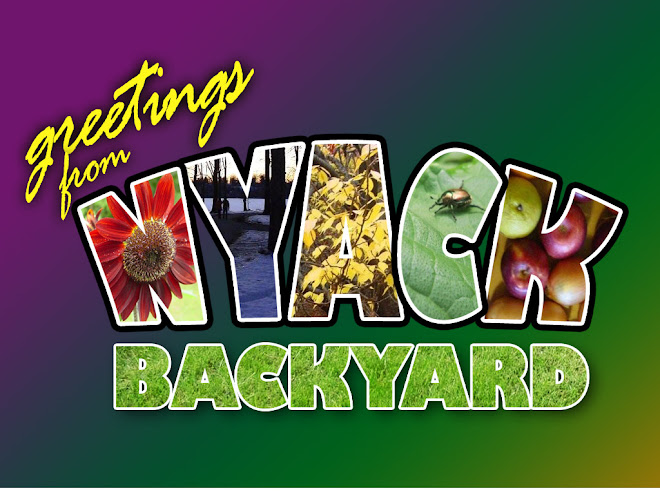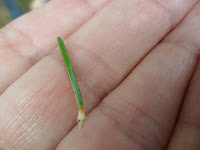Our walk began with the Linden Tree in the parking lot.
1) Linden Trees (Tilia) are insect pollinated, so they can bloom AFTER the leaves appear. Wind pollinated plants bloom before the leaves appear, because the leaves inhibit the flow of pollen. Tea, honey and scented oils are made from linden blossoms. Our guide brought us sample of linden tea (which she served with some yummy homemade lemon madeleines!)
2) When White Clover (Trifolium repens) has been pollinated, the lower petals fold down. That sends a message to pollinators not to bother with this one.
3) MADCAP HORSE is an acronym that helps you remember which trees and shrubs have opposite leaves so that you can identify them.
M = Maple
A = Ash
D = Dogwood
CAP = Caprifoliaceae - viburnums and honeysuckles
HORSE = Horse Chestnut
4) Spruce (picia) v. Fir (abies)- One way to identify conifers is to pull off a needle. If it is a single needle (rather than several in a package) it is most likely a spruce or fir. A spruce needle has 4 sides- "S" is for "Square" and "Spruce." A fir needle is flat. "F" is for "Flat" and "Fir." You'll be able to tell the shape by rolling the needle between two fingers.
5) One legend says that Queen Anne's Lace (daucus carota) is so named because Queen Anne, a champion lacemaker from Denmark, challenged her ladies in waiting to a contest to see who could make the prettiest lace, and Queen Anne, being the queen, won.
Queen Anne, Queen Anne, has washed her lace
(She chose a summer's day)
And hung it in a grassy place
To whiten, if it may.
Queen Anne, Queen Anne, has left it there,
And slept the dewy night;
Then waked, to find the sunshine fair,
And all the meadows white.
Queen Anne, Queen Anne, is dead and gone
(She died a summer's day),
But left her lace to whiten in
Each weed-entangled way!
By Mary Leslie Newton
6) Sassafras- (sassafras albidum) has 3 different leaves: One that looks like a mitten, one with three lobes, and one a simple oval. The root was used to flavor root beer until it was discovered that the distilled oil causes cancer, and it was banned by the FDA.
7) Lichen
"Algae, you're a fungi, I think I've taken a lichen to you...." Lichen are both algae and fungi living together. Lichen are harmless to trees and very sensitive to air pollution.
8) St. John's Wort (Hypericum perforatum) produces an oil that, when consumed by cattle, makes them photosensitive. When the plant overtook some California farmland, the cattle started getting terrible sunburns, and a special beetle had to be introduced to get it under control.
9) Which Maple (acer) is this? Squeeze the tip of the leaf twig. If a white milky extract comes out, it's a Norway Maple. If none, it could be a Red or Sugar Maple. Red Maples have teeth along the edge. Sugar Maples do not. The shape of a Red Maples is like a cat in a ski cap.
 10) Milkweed (asclepias) have a little slit on the side that can trap a pollenator and force him to carry hunks of pollen out with her when she leaves.
10) Milkweed (asclepias) have a little slit on the side that can trap a pollenator and force him to carry hunks of pollen out with her when she leaves.Dr. Petro's talk stressed the importance of planting native species when given a choice, and the role of native plants in our ecosystem. It will be very hard to walk through the woods, or even my backyard now without recalling these valuable lessons, and feeling grateful to have had this opportunity.











10 comments:
Even when we pick and let the native plants grow in our garden, the right balance or proportion must be there... ~bangchik
Thanks for sharing. It's nice when someone can share their knowledge, entwinted with rich story, in a way that make the lessons stay with us.
What a great post! I learned so much. I've been tip-toeing around my yard full of white clover for days knowing that my bees were enjoying the nectar. Now I can tell which flowers the bees won't be on so I can tip-toe a little faster. Thanks!
What a wonderful post, Jen. I felt like I had the privilege of joining you on the hike - though I wish I could have tasted one of those lemon madelines :). That is so neat about the clover - I'm going to watch the bees pass over the down-tipped ones this year. I learned so much. Thank you!
The plant kingdom is so interesting, isn't it? That clover, milkweed and sassafras are tricky little ones.
Her knowledge is amazing and surely to be envied. Thanks for sharing some of it.
sounds fascinating - what a great day :-)
I went on a similar nature walk and we sampled some sassafras, which I really enjoyed, but I had no idea it was banned by the FDA! Thanks for posting this info. If you're ever on the other side of the river, the "Wild Man" Steve Brill leads walks in the city, Westchester, Putnam and Dutchess. We went on one in Central Park and it was fantastic.
You are AMAZING! Thanks for a horticultural tour!
Patti
fascinating---really feel sorry for sunburned cows :(
Post a Comment